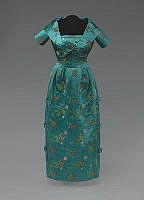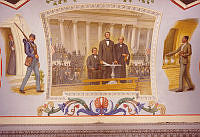Rubenstein Center Scholarship
"Running from the Temple of Liberty": The Pearl Incident
This article is part of the Slavery in the President’s Neighborhood initiative. Explore the Timeline
On April 15, 1848, the Pearl schooner was docked at the wharf located at the foot of Seventh Street in Washington, D.C., waiting for passengers to arrive. The wharf was situated in a less-traveled area of Southwest D.C. and was chosen for its secluded location. The high riverbank, wide stretches of fields, and the lack of buildings in the vicinity provided the secrecy that the Pearl’s passengers required.1 Over the course of the evening, seventy-seven enslaved people silently boarded the schooner. To avoid raising any suspicion, the passengers hid below deck. By the end of the night, there were thirty-eight men, twenty-six women, and thirteen children huddled together in the cargo hold, all willing to risk their lives to escape slavery. Under the cover of night, the Pearl lifted anchor and set sail along the Potomac River toward the Chesapeake Bay, and charted course towards Frenchtown, New Jersey. Changing tides and unfavorable winds slowed the schooner’s progress. The Pearl’s enslaved passengers anxiously waited in the hold, hoping that no one would notice their absence.
The plans for the escape were orchestrated months before the Pearl departed from Washington. Free African Americans in D.C. worked with antislavery advocates to establish the plan, seeking to secure freedom for their enslaved friends and family. Daniel Bell and Samuel Edmonson, who were both free Black men with connections to white abolitionists in D.C., are credited as organizers for the escape on the Pearl.2 Another person affiliated with the escape was Paul Jennings.3 Jennings was formerly enslaved by James and Dolley Madison. During James Madison’s administration, he was enslaved at the White House as the president’s personal valet and the first lady’s dining room servant. He later was hired out by Dolley Madison to work in President James K. Polk’s White House for several months in 1845. In 1847, Jennings was purchased by Massachusetts Senator Daniel Webster, and the two agreed that Jennings would receive his freedom while working for Webster to pay off the debt. After gaining his own freedom, Jennings sought to help other enslaved people by supporting abolitionists and organizing escape routes out of Washington. Click here to learn more about the enslaved household of President James Madison. Click here to learn more about the enslaved households of President James K. Polk.
On behalf of the free African Americans organizing the escape, abolitionist William Chaplin hired Daniel Drayton, who lived in Philadelphia, Pennsylvania, to procure a sailing vessel to carry out their plan.4 Drayton had previous experience assisting enslaved people with escape and had helped an enslaved woman and her children seeking transportation out of D.C. during the summer of 1847. He was familiar with the route and agreed to take the job.5 Drayton hired Edward Sayres, the captain of the Pearl schooner, to help him transport the enslaved passengers out of Washington. To protect the identities of the Pearl’s future passengers, the names and the exact number of enslaved people were kept secret from Drayton and Sayres. A third crew member, Chester English, was hired by Sayres as a cook; however, Drayton and Sayres did not inform English of their plan until they arrived in Washington.

This is an image of Daniel Drayton found in his memoir about the Pearl incident.
Library of CongressAs Drayton, Sayres, and English set sail from Philadelphia, the enslaved people hoping to escape on the Pearl made preparations to board the schooner on April 15. Among the seventy-seven enslaved people planning to board the Pearl was Ellen Stewart, who was fifteen years old and one of former First Lady Dolley Madison’s enslaved maids. Following James Madison’s death in 1836, Mrs. Madison went back and forth between Montpelier plantation and her house on Lafayette Square in Washington, D.C. She typically and brought several of her enslaved workers with her, including Ellen and Ellen’s mother, Sukey.6 Most of the Madisons’ enslaved laborers continued to work at the Montpelier plantation.
When Mrs. Madison accumulated significant debts from her son Payne Todd’s irresponsible spending and mismanagement of the Montpelier plantation, she hired out or sold many of her enslaved laborers to pay for her expenses.7 By selling enslaved people, Mrs. Madison forcibly separated families within the enslaved community. She sold Ellen’s brother, Ben, to work in Georgia, and she planned to sell Ellen’s brother, William. However, William passed away at the age of fifteen.8 After witnessing her brother and other enslaved workers being sold, Ellen feared that Mrs. Madison would also sell her to pay off debts. In December 1847, Mrs. Madison asked Ellen to bring water into the parlor for a guest. Unknown to Ellen, Mrs. Madison’s guest was an unnamed slave trader, and she had organized the meeting to covertly arrange a deal to sell Ellen. Mrs. Madison worried that Ellen would attempt to run away if she knew the true intentions of the meeting. After finalizing the agreement with the slave trader, Mrs. Madison sent Ellen to the public pump in Lafayette Park to fetch water. During the errand, the slave trader intended to seize Ellen; however, she suspected that the guest was a slave trader. Ellen fled from the neighborhood and went into hiding.9

This is an image of Dolley Madison's house on Lafayette Square where Ellen Stewart worked.
Library of CongressEllen was on the run and successfully evaded capture for five months prior to the Pearl. She likely received help from friends among the free black community. One such friend was Paul Jennings, who knew Ellen when he was enslaved by the Madisons. The two were also neighbors, as Jennings worked at Senator Webster’s nearby residence across the square. On behalf of Senator Webster, Jennings frequently delivered provisions to Mrs. Madison, as well as any necessities that she lacked. Occasionally, Jennings gave Mrs. Madison some of his own money to help her cover expenses.10 When he visited Mrs. Madison’s residence, Jennings probably saw and even communicated with Ellen. Their proximity suggests that Jennings may have helped Ellen evade her captors and possibly even reserved a spot for her on the Pearl.
After Ellen and her fellow passengers boarded the Pearl and set sail, the crew and passengers’ journey encountered several setbacks due to unfavorable weather conditions. At the mouth of the Potomac River, the Pearl schooner faced adverse winds from the north. Unable to continue their course to New Jersey, the Pearl anchored for the night near Point Lookout, Maryland. The next morning, thirty white volunteers and slave owners aboard the Salem steamer overtook the Pearl with weapons in hand.11
It is unclear exactly how the slave owners discovered the details of the Pearl’s escape. In his memoir, Daniel Drayton identifies as an unnamed “colored hackman” as the person who informed the slave owners of the plan. According to Drayton, the informer had been hired to help two of the Pearl’s freedom seekers board the schooner and betrayed the plan in exchange for a financial reward.12 Another source suggests that an enslaved man named Anthony Blow, who worked as a blacksmith alongside Daniel Bell, revealed the plan after police interrogation.13 Most sources suggest that Judson Diggs, a formerly enslaved man, betrayed the plan. However, there are different accounts of his motivations.14

On April 20, 1848, President James K. Polk wrote about the Pearl incident and the mob surrounding the National Era in his diary.
Library of CongressThe Pearl’s passengers and crew members were then shackled and paraded through the streets of Washington. In his memoir, Drayton described the harrowing scene: “We met an immense mob of several thousand persons coming down Four-and-a-half street, with the avowed intention of carrying us up before the capitol, and making an exhibition of us there. The noise and confusion was very great. It seemed as if the time for the lynching had come.”15 The Pearl crew and passengers avoided harm from the mob and were placed in the D.C. jail.
Over the next three days, riots formed in response to the Pearl incident. Although the owners of the Pearl’s freedom seekers were angered by the escape attempt, the majority of the outrage was directed toward Drayton and Sayres for assisting these enslaved people.16 Mobs of people surrounded the jail holding Drayton and Sayres and continued to threaten them. Angry crowds also threatened the offices of the National Era, an abolitionist newspaper. When President James K. Polk learned the details of the Pearl incident and the threats against the National Era, he worked with the police to maintain peace in the city and prevent the mobs from turning violent.17 In his diary entry for April 20, 1848, Polk wrote: “I told Mr. Whittlesey that I would cooperate with the City authorities, if necessary, in any proper steps to preserve the public peace & to cause the laws to be respected.”18 Polk’s intervention was not a display of support for the Pearl freedom seekers and the National Era, but rather an attempt to quell rising tensions between proslavery and antislavery groups within the nation’s capital.
Many of the Pearl freedom seekers were sold and transported to the Deep South, where they were sent to labor on cotton plantations. One D.C. slave trader named Hope Slatter purchased fifty of the enslaved people, including Ellen, who were captured on the Pearl to be resold in the South.19 Slatter transported Ellen and the Pearl freedom seekers to Walter L. Campbell’s slave pen in Baltimore, Maryland.20 Despite their failed attempt at escape on the Pearl, many antislavery advocates collectively raised funds to purchase some of the enslaved prisoners’ freedom. William Chaplin and Dr. Joseph Evans, a Baltimore physician and antislavery publisher, were among those who raised the necessary funds to purchase Ellen’s freedom.21 After gaining her freedom, Ellen moved to Boston, Massachusetts, where she married Thomas White. She later returned to Washington, D.C. with her daughter, Gertrude.22

This article in the April 19, 1848 issue of The Washington Daily Union gives an incomplete list of the Pearl freedom seekers.
Library of CongressAs the enslaved freedom seekers of the Pearl waited to learn their fates through separation and sale, Daniel Drayton and Edward Sayres prepared for trial with assistance from congressmen Joshua Giddings, Edward Hamlin, and David Hall. Abolitionists and antislavery congressmen attempted to use the attention on the Pearl incident to sway popular opinion regarding slavery in the nation’s capital.23 Although the escape on the Pearl was unsuccessful, it provided antislavery leaders with a public event that demonstrated support for the abolition of slavery. Antislavery advocates introduced the events of the Pearl incident into resolutions and debates in Congress to support their arguments against slavery. On April 20, 1848, Massachusetts Representative John Palfrey introduced a motion to appoint a committee to investigate mob violence against a member of the House of Representatives during the Pearl incident. Representative Giddings and Senator John Hale also delivered speeches and resolutions before Congress, referencing the riots that occurred in response to the attempted escape.24 Through their resolutions, the antislavery congressmen provoked debates on the topic of slavery. Although Congress did not take action in response to the Pearl incident and the antislavery congressmen’s resolutions, the antislavery advocates successfully gained press coverage that helped them gain support from northern public audiences.
Tensions between proslavery and antislavery advocates were also raised, in part, due to the events of the February 1848 revolution in France. The day that Drayton, Sayres, and English arrived in Washington, they came across a celebration “in honor of the new French revolution, the expulsion of [King] Louis-Philippe, and the establishment of a republic in France.”25 Additionally, a little over a week after the Pearl incident, President Polk was invited to join a procession of citizens celebrating the revolution in France.26 Antislavery activists lambasted proslavery individuals’ praises of freedom and liberty associated with the 1848 French Revolution while they simultaneously supported slavery and the slave trade in the United States. Writing for the North Star in support of Drayton, Sayres, and English’s participation in the Pearl incident, Frederick Douglass noted the irony:
Slaves escaping from the Capital of the ‘model Republic!’ What an idea!—running from the Temple of Liberty to be free! Then, too, our slaveholding Belshazzars were in the midst of feasting and rejoicing over the downfall of Louis Philippe, and the establishment of a republic in France!27

When the Pearl's crew and passengers reached Point Lookout, Maryland, they planned to sail north through the Chesapeake Bay to reach Frenchtown, New Jersey.
W. L. Nicholson, Cartographer, Library of CongressWhen Drayton and Sayres went to trial in July 1848, antislavery activists used the opportunity to publicly denounce slavery. Massachusetts Representative Horace Mann volunteered to serve as their legal counsel.28 During one of the sessions, Mann read an excerpt from a speech that Mississippi Senator Henry Foote gave in honor of the 1848 French Revolution. Mann criticized the hypocrisy of Foote and other proslavery advocates. Like Frederick Douglass, he argued that slave owners’ praises of freedom and liberty were inherent rights that belonged to all human beings, including enslaved individuals.29 At the conclusion of the trials, Sayres pleaded guilty to transporting escaped enslaved people and Drayton was found guilty of larceny. Sayres received fines and Drayton was sentenced to twenty years in prison. They appealed their sentences in November and received a new set of trials in February 1849. During the second round of trials, the larceny charges were dropped but Drayton and Sayres pleaded guilty to transporting enslaved freedom seekers. Since they did not have enough money to pay their fines, both Drayton and Sayres remained in jail indefinitely.

Daniel Drayton, Edward Sayres, and Chester English docked the Pearl schooner at the Seventh Street wharf. After the enslaved passengers boarded the schooner, they sailed east of Washington, D.C. on the Potomac River.
Casimir Bohn and E. Sachse & Co., Library of CongressDuring the spring of 1852, Massachusetts Senator Charles Sumner presented a legal brief to President Millard Fillmore on behalf of Drayton and Sayres, requesting their release from jail by presidential pardon. President Fillmore hesitated to grant the pardon for fear of losing support from the South. After President Fillmore failed to receive the Whig Party’s nomination as its presidential candidate, he reluctantly agreed to pardon Drayton and Sayres in August 1852.30
The effects of the Pearl incident toward abolishing slavery did not manifest in legislation until the Compromise of 1850, which abolished the slave trade in Washington, D.C. Nevertheless, the history behind the Pearl incident demonstrates that enslaved people, the free African American community, and abolitionists collaborated in pursuit of freedom, and contributed to changing attitudes toward slavery’s place in the nation’s capital.










